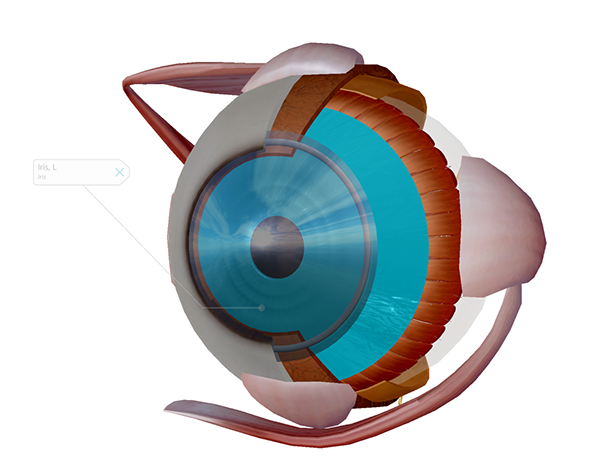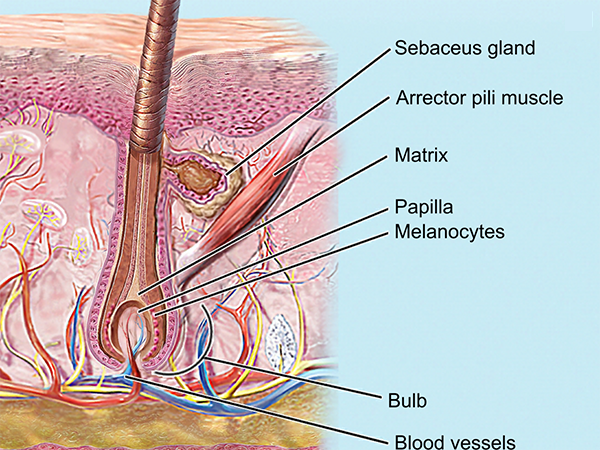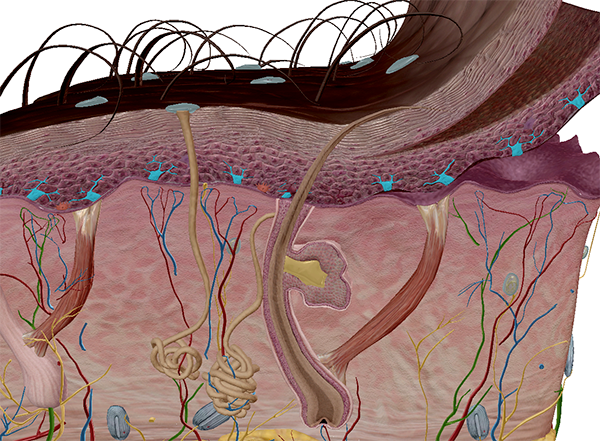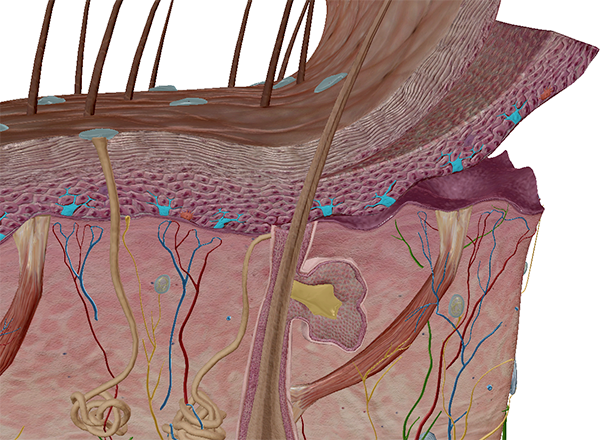Marvelous Melanin: A Pigmentation Primer
Posted on 7/5/22 by Laura Snider
One of the coolest things about humans is how varied we are in appearance—we have a wide range of eye, hair, and skin colors that make us unique! Though these traits are regulated by many different genes, they have one very important thing in common: a pigment called melanin. In this blog post, we’ll take a look at how different amounts and types of melanin determine the color of your eyes and hair, why people's hair goes grey with age, and how melanin protects the skin from UV rays (contributing to our ability to tan!).
Eye color varies with the amount of melanin in the iris
Like hair color and skin color, eye color ultimately comes down to how much melanin is present in a particular structure—in this case, the iris of the eye. The iris is a thin disk suspended between the cornea and the actual lens of the eye. It’s not just there to look pretty—it regulates the amount of light that passes through the pupil of the eye by adjusting the pupil’s size.
 The iris of the eye in Human Anatomy Atlas.
The iris of the eye in Human Anatomy Atlas.
A high concentration of melanin gives the iris a brown color, and there is a lot of variation just within this category, from light brown to almost black! A moderate concentration of melanin results in a greenish or hazel iris, and a low concentration of melanin results in a blue iris.
Ever wonder why babies’ eye color changes after they’re born, or why some babies are born with blue or grey eyes that eventually become brown? The answer is, once again, melanin! (By the way, lots of babies are born with brown eyes from the get-go. It’s a myth that all babies are born with blue eyes.)
Melanocytes are special cells that secrete melanin—we’ll be talking about them a lot throughout this article. If a brown-eyed person had blue eyes as a newborn, that’s because it can take some time (typically around a year or so) for the melanocytes in an infant’s eyes to produce the level of melanin that will result in their eventual “true” eye color.
What determines how much melanin cells in the iris will produce? It probably won’t surprise you to know that eye color is a trait that’s passed down from parents to their children. There are two genes that are involved in eye color in a major way: OCA2 and HERC2. They can be found close together on chromosome 15. Essentially, OCA2 contains the instructions for building a protein that is involved in the maturation of melanosomes, structures inside cells that produce and store melanin. A particular sequence of HERC2 regulates the activity of OCA2.
Medline Plus lists a few other genes that have been connected to eye color, including ASIP, IRF4, SLC24A4, SLC24A5, SLC45A2, TPCN2, TYR, and TYRP1. Based on the results of a recent GWAS (genome-wide association study), there could potentially be even more genes whose activity contributes to eye color (we’re talking more than 50!).
Different levels of eumelanin and pheomelanin create different hair colors
Every hair on the human body has three main parts: a root, a follicle, and a shaft. The shaft is the part of the hair that’s visible—it’s made of dead keratinized cells. The root is where new cells are produced, pushing the shaft of the hair up and out. The follicle is a sheath containing the root and the part of the shaft that sits below the surface of the skin.
 Melanocytes in the root of a hair. Illustration from A&P.
Melanocytes in the root of a hair. Illustration from A&P.
The bulb-shaped bottom portion of the root contains melanocytes (just like the iris and the skin itself). These cells produce two different types of melanin—eumelanin and pheomelanin—and a person’s hair color depends on the type and amount of melanin the melanocytes in the root produces. Just as with eye and skin color, more melanin will generally result in a darker pigment. A large amount of eumelanin results in black hair, while a moderate amount of eumelanin results in brown hair. Blonde hair is a result of very little eumelanin. Pheomelanin determines how red a hair is—so a person with bright red hair likely has melanocytes that produce a lot of this type of melanin and a little eumelanin.
The activity of particular genes is responsible for the levels of each type of melanin produced by these melanocytes. MC1R is the best-studied gene that has an effect on hair color. It contains the instructions for making a protein (the melanocortin 1 receptor) that stimulates cells to make eumelanin.
Hair color isn’t constant throughout a person’s lifespan. For instance, hormones can alter the activity of the abovementioned melanocytes and cause hair color to change—this is typically what’s happening when a child or teenager has a change in hair color. Many people choose to dye their hair to change its color—if they have dark hair (which contains a lot of melanin) they often “bleach it,” using chemicals to render its pigments colorless, before applying a new color.
Just like the rest of the body, melanocytes age. In young people, they’re replaced pretty much right away, but this replacement process slows down as we get older. When a melanocyte grows old and is not replaced, it doesn’t pass on its pigments properly, and the result is grey or white hair.
Melanin protects the skin from UV radiation
When it comes to variation and a wide range of influential genes, skin color is a complex trait. Still, melanin production by melanocytes is at the core of what causes skin to appear lighter or darker.
The primary purpose of melanin in the skin is to protect it from UV rays. While all humans have roughly the same concentration of melanocytes in the epidermis (outermost layer) of the skin, the amount of melanin they produce can differ widely based on a person’s genes as well as exposure to the sun.

 Melanocytes in the epidermis of darker pigmented skin (upper image) and lighter pigmented skin (lower image).
Melanocytes in the epidermis of darker pigmented skin (upper image) and lighter pigmented skin (lower image).
These updated skin microanatomy models are now available in Human Anatomy Atlas 2022+!
More than 20 genes have been found to influence skin color variation, and many more are associated with melanin production in general. And when I say many, I’m not exaggerating—this 2010 paper puts the total number of genes that directly or indirectly affect skin color at around 150!
In lots of people, sun exposure triggers the production of melanin in the skin, resulting in a tan. It’s their skin’s way of trying to protect itself against future UV damage, although it’s worth mentioning that just because you have a tan doesn’t mean you can’t still get sunburn (sorry). Some people are more likely to get sunburn than they are to tan, which is likely influenced by our genes—a GWAS study conducted in 2018 connected around 20 genes to people’s tendency to tan.
Individuals with darker skin have a bit more natural UV protection than those with lighter skin, but we can all still get sunburn and skin cancer, so it’s important for everyone to protect their skin with sunscreen and protective clothing if they plan to be outside for a long time.
Ultimately, melanin and the genes and environmental factors that regulate its production in our cells play an important role in giving each of us our unique appearance. Now that is one multitalented pigment!
Want to learn more about the anatomy and physiology of the eyes, hair, and skin? Explore the differences between darker and lighter skin pigmentation and curly and straight hair with the new skin microanatomy models in Human Anatomy Atlas 2022+!
You can also check out these related VB Blog posts:
- Anatomy and Physiology: The Anatomy of Vision
- Let’s Untangle This: All About Hair
- Anatomy and Physiology: Five Things About the Integumentary System
Be sure to subscribe to the Visible Body Blog for more anatomy awesomeness!
Are you an instructor? We have award-winning 3D products and resources for your anatomy and physiology course! Learn more here.



